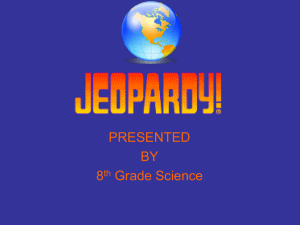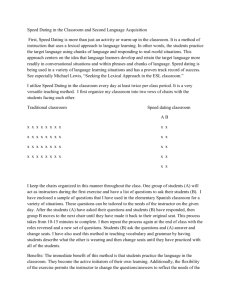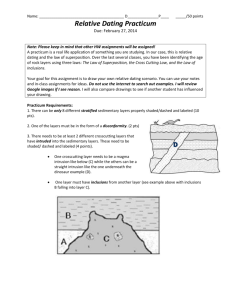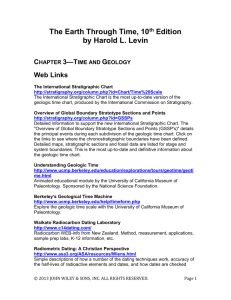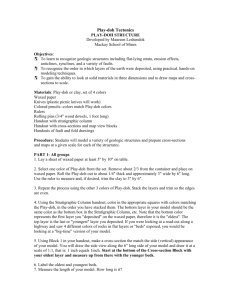Relative Dating Lab: Stratigraphy & Rock Layers
advertisement
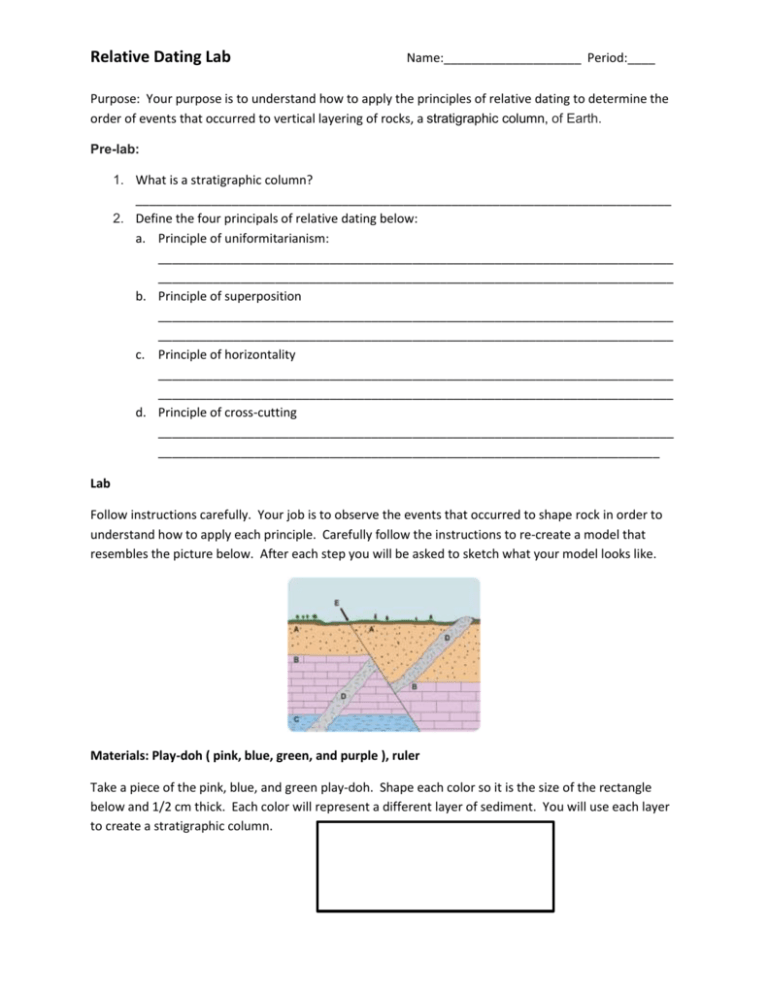
Relative Dating Lab Name:____________________ Period:____ Purpose: Your purpose is to understand how to apply the principles of relative dating to determine the order of events that occurred to vertical layering of rocks, a stratigraphic column, of Earth. Pre-lab: 1. What is a stratigraphic column? ______________________________________________________________________________ 2. Define the four principals of relative dating below: a. Principle of uniformitarianism: ___________________________________________________________________________ ___________________________________________________________________________ b. Principle of superposition ___________________________________________________________________________ ___________________________________________________________________________ c. Principle of horizontality ___________________________________________________________________________ ___________________________________________________________________________ d. Principle of cross-cutting ___________________________________________________________________________ _________________________________________________________________________ Lab Follow instructions carefully. Your job is to observe the events that occurred to shape rock in order to understand how to apply each principle. Carefully follow the instructions to re-create a model that resembles the picture below. After each step you will be asked to sketch what your model looks like. Materials: Play-doh ( pink, blue, green, and purple ), ruler Take a piece of the pink, blue, and green play-doh. Shape each color so it is the size of the rectangle below and 1/2 cm thick. Each color will represent a different layer of sediment. You will use each layer to create a stratigraphic column. Relative Dating Lab Name:____________________ Period:____ After you have completed each step of modeling, draw and color what your model looks like after that step. Step 1 is drawn for you. Make sure you color it. If there are any blanks in the instructions, make sure you fill them in. 1. Deposit sediment layer C. Take your blue layer and lay it flat on the table. The principle of _______________ states that when sediment layers are created they are formed flat. Picture: Blue 2. Deposit sediment layer B. Take your pink layer and lay it flat on top of your blue layer. Since the pink layer was just deposited, it is younger than the blue layer which is explained by the principle of _________________________. Picture: 3. Deposit sediment layer A. Take your green layer and lay it flat on top of your pink layer. Now the oldest layer is the _____________ layer and the youngest layer is the ____________ layer. Picture: 4. Create the intrusion D. Magma has risen from below the surface of the Earth. The magma is so hot and has enough pressure behind it that it has moved through each layer. The magma has reached the surface and hardened. The hardened magma is called a _______. Relative Dating Lab Name:____________________ Period:____ We know the intrusion D occurred after the layers where formed due to the principle of _____________________. Roll up the purple play-dough and push into the side of your layers. Picture: 5. Create fault E. An earthquake has occurred due to the plates ________________ at the fault boundary. This has caused the sediments layers to shift at the fault. Make a diagonal cut through the your layers and shift the two halves so the colors are no longer aligned horizontally. Picture: 6. Does your final picture match with original picture that was provided to you? If no, what steps need to be added? ___________________________________________________________________________ ___________________________________________________________________________ ___________________________________________________________________________ ___________________________________________________________________________ Make sure to clean up after you are done. The play-doh colors should be carefully separated and placed back in the correct container. Signature of teacher:_______________ Post Lab 1. Use your knowledge of what you learned to label the diagram in sequence order on the next page. You may use your play-doh to assist you in determining the order. Use numbers to label the order. 1 representing the first event that occurred and 11 representing the last event that occurred. Relative Dating Lab Name:____________________ Period:____ 2. In the above picture, the bottom layers are not flat but at are tilted. What Earth process would cause the rock layers to tilt? ___________________________________________ 3. At the top of the above picture, what Earth process occurred to cause the v shaped gap? _______________________________________________________________________ 4. Use your knowledge from the lab to describe the sequence of events that occurred to create the rock column picture above. You must include and highlight the following words: dike, fault, earthquake, plates, and erosion. ________________________________________________________________________ ________________________________________________________________________ ________________________________________________________________________ ________________________________________________________________________ ________________________________________________________________________ ________________________________________________________________________ ________________________________________________________________________ ________________________________________________________________________ ________________________________________________________________________ ________________________________________________________________________ ________________________________________________________________________ ________________________________________________________________________ ________________________________________________________________________ ________________________________________________________________________ Relative Dating Lab Name:____________________ Period:____ ________________________________________________________________________ ________________________________________________________________________



